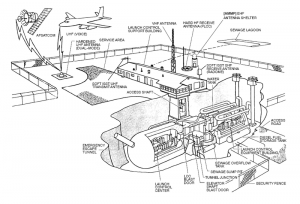Missile Silo Research Synopsis
In the 1960’s, the US government constructed the largest and most complex weapon system to date for the purpose of intercontinental missile defense. The project, the WS-107A-2, also called the Titan I Weapon System for development surrounding the Titan I missile, involved over 2200 defense and civil contractors, and employed thousands of people to maintain. Concurrently, the government developed a second weapons system, the Atlas ICBM (intercontinental ballistic missile), for the Atlas series of missiles, to allow for a backup system should one system fail.
Located in various key and strategic areas around the US (ie Washington, California, South Dakota, Idaho, and Colorado), the missile complexes, or missile silos, were practically underground cities, built to support crew and operations necessary to provide a pre-emptive or retaliatory strike in the face of a nuclear war.
It was with the fourth version of the Atlas ICBM (Atlas-F) and the Titan I that the missiles were stored vertically in underground silos. With this basing system, weapons could not be launched from within the silo; they had to be fueled in the silo then raised for the surface for launch. Later, with the introduction of the Soviet UR-100 and the Titan II missiles series, fuel was stored within the missiles allowing them to be launched from the silos.
Launch Facility (LF) configurations varied by missile system, with the Titan II’s based in a launch facility connected through tunnels to the launch control center (LCC). The launch control center was where the missile combat crew could monitor the complex, launch the missile or rest in the living quarters. They were underground structures constructed of reinforced concrete and steel sufficient to withstand a weapons attack. The Titan II launch control centers were housed in three-story domes. The first level contained the crew’s living quarters with kitchen, bathroom, bedroom. The second level contained the main launch console, as well as an alternate launch console and the control monitor group which monitored the missile. The lowest level contained the communications equipment, battery backups, motor generator and other key equipment. The more updated blast-proof Minuteman facilities were cylindrical shaped with hemispherical ends and walls approximately 4.5 ft thick, suspended like a pendulum by four shock isolators. A vertical access shaft led into a tunnel juncture, and the LCC could be accessed through a blast door. In the event of an attack that damaged the vertical shaft, a 3-ft in diameter escape hatch was built into the far end of the LCC leading to an escape tunnel.
The missile combat crews were supplied by the US Air Force, and Strategic Air Command mandated a “two-man rule” designed to prevent accidental or malicious launch of weapons by a single individual. In the Titan II system, the LCC generally had four crew members—the Missile Combat Crew Commander (MCCC), the Deputy Missile Combat Crew Commander (DMCCC), the Ballistic Missile Analyst Technician (BMAT), and the Missile Facilities Technician (MFT).
In the case of the Minuteman missile, the only currently ICBM active in the US, several things must be in place in order to launch the missiles. First, the missile must be at full alert status, with no safing devices installed, have a correctly programmed computer, and the on board launch code verification devices must be correctly coded. Any one of several commands, from any of the networked launch control centers in the same squadron of 50 missiles, can change one of these factors, and make a launch impossible. The President, or his surviving replacement, must release the launch codes, also known as the Universal Unlock Code. They must then be transmitted by the NCA in an Emergency War Order (EWO) message, and authenticated by the launch crews. Both operators must agree that the launch order is valid by comparing the authorization code in the launch order against the code from the Sealed Authenticator, contained in a sealed envelope stored in a safe with two separate locks positioned in such a way that no single crew member can simultaneously turn the keys and open the safe alone.
Once authenticated, these codes must be manually entered into the proper devices at the LCC by the crew, and then they each must insert a key into a sealed switch unit, and turn the keys simultaneously to transmit a “launch vote”. For additional protection, the missile crew in another launch control center in the missile network must carry out the same authorization procedure and send out launch votes in order for the missiles to be launched. There is also a procedure for the “Single Survivor” situation in the event only one control center is available, though other conditions must be fulfilled for a successful launch. And again, any of the other LCC’s could stop the launch. For a conspiracy to take over control of a Minuteman launch, it would require several people in key military and government positions, all working in a concerted effort.
Sources:
http://www.chromehooves.net/
http://en.wikipedia.org/wiki/Launch_control_center_%28ICBM%29
http://en.wikipedia.org/wiki/Missile_silo
http://www.afmissileers.org/
